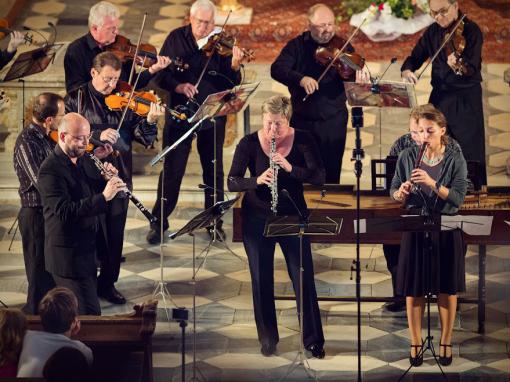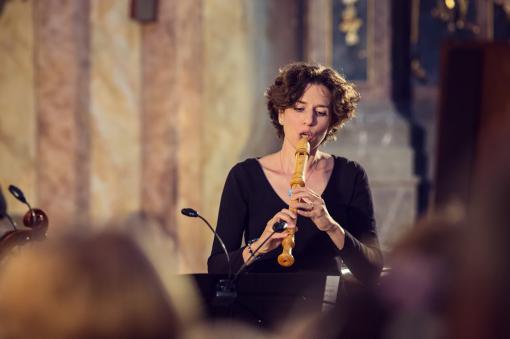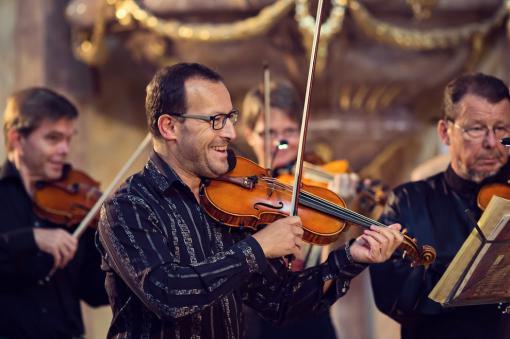A trio of concerts with the same programme as performed by Czech Virtuosi in early September in monasteries in Vranov, at the Grohova Street in Brno and in Doubravník can be considered as much a final goodbye to a beautiful holiday (a visit to the church delicately set into a beautiful landscape is in itself one of the noblest tourist experiences) as a step into the new concert season. Let's remind ourselves that the Brno ensemble with the difficult English-Italian name has been filling the space between large orchestras and chamber ensembles since its founding in 1998 in more than just the Brno concert life - so far they have performed a third of their concerts abroad. And they do so at a high level: its members are top players from the Philharmonic Orchestra and the Opera Orchestra, led by the concert master Pavel Wallinger from his stand.
 The culmination of the three-part event was probably the Sunday concert (4 September) in the Monastery of the Exaltation of the Holy Cross in Doubravník. Its unique architecturally rhythmic, yet rarely integrated interior that organically ties together the dominant features of late Gothic with Renaissance and peak Baroque features proved to be the perfect setting for a six-part, 60-minute show consisting of pieces of composers from the 18th century, each of whom is looking for their own way from the Baroque base to the new style. The Baroque basis was represented in the show by Bach's famous Air, performed – as it should - with continuo; it differed from the ordinary (and knowledgeable) interpretation mainly in the sensitive phrasing of the seemingly single-breath two-part performance, convincingly led to an expressive peak five times before the end. On the contrary – the closest to the Mozart Classicism, however, proved to be the initial Quintet in A Major by Josef Mysliveček; a certain disadvantage of his orchestral conception was that each of the two viola voices were played by only one player. However, if the listener got used to perceiving the orchestral sound as a whole in the long acoustics of the space of the monastery, they did not necessarily have to mind. The little-known three-sentence Symphony in C major in the gallant style of František Benda also impacted the experienced listener as a nice discovery. The supreme experience, however, was the composition by František Xaver Richter Adagio a fuga g moll: here, the composer, who became the pioneer of the new style during his time in the famous Mannheim band, proves how deep the idea of a Baroque counterpoint as a bearer of the massive expression was embedded. And the orchestra concentrated on it. Due to the frequent inclusion of this composition in the programme, the orchestra no longer sees its technical pitfalls.
The culmination of the three-part event was probably the Sunday concert (4 September) in the Monastery of the Exaltation of the Holy Cross in Doubravník. Its unique architecturally rhythmic, yet rarely integrated interior that organically ties together the dominant features of late Gothic with Renaissance and peak Baroque features proved to be the perfect setting for a six-part, 60-minute show consisting of pieces of composers from the 18th century, each of whom is looking for their own way from the Baroque base to the new style. The Baroque basis was represented in the show by Bach's famous Air, performed – as it should - with continuo; it differed from the ordinary (and knowledgeable) interpretation mainly in the sensitive phrasing of the seemingly single-breath two-part performance, convincingly led to an expressive peak five times before the end. On the contrary – the closest to the Mozart Classicism, however, proved to be the initial Quintet in A Major by Josef Mysliveček; a certain disadvantage of his orchestral conception was that each of the two viola voices were played by only one player. However, if the listener got used to perceiving the orchestral sound as a whole in the long acoustics of the space of the monastery, they did not necessarily have to mind. The little-known three-sentence Symphony in C major in the gallant style of František Benda also impacted the experienced listener as a nice discovery. The supreme experience, however, was the composition by František Xaver Richter Adagio a fuga g moll: here, the composer, who became the pioneer of the new style during his time in the famous Mannheim band, proves how deep the idea of a Baroque counterpoint as a bearer of the massive expression was embedded. And the orchestra concentrated on it. Due to the frequent inclusion of this composition in the programme, the orchestra no longer sees its technical pitfalls.
 An attractive enrichment of the concert was the participation of four wind soloists in the final B flat major Concerto for two recorders, two oboes, strings and basso continuo by Georg Philipp Telemann. The soloists (Martina Komínková, Anna Todorová, Rastislav Kozoň and Martina Vávrová, the first of whom presented also Ciaccona by Gottfried Finger with continuo as the second number) brought new life into the monastery after the end of the spectacular composition by Richter and gave the grateful audience an opportunity for ovation. The Doubravník Church, which owes its splendour not only to the long-term care of the powerful Pernštejn dynasty, but recently mainly to people, who like it, deserves to be not only one of the stops on tourist trips but also a spiritual and cultural centre corresponding to its historical significance even in today's unique form.
An attractive enrichment of the concert was the participation of four wind soloists in the final B flat major Concerto for two recorders, two oboes, strings and basso continuo by Georg Philipp Telemann. The soloists (Martina Komínková, Anna Todorová, Rastislav Kozoň and Martina Vávrová, the first of whom presented also Ciaccona by Gottfried Finger with continuo as the second number) brought new life into the monastery after the end of the spectacular composition by Richter and gave the grateful audience an opportunity for ovation. The Doubravník Church, which owes its splendour not only to the long-term care of the powerful Pernštejn dynasty, but recently mainly to people, who like it, deserves to be not only one of the stops on tourist trips but also a spiritual and cultural centre corresponding to its historical significance even in today's unique form.































